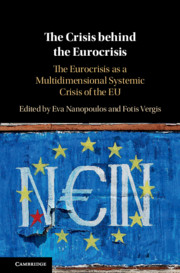Book contents
- The Crisis behind the Eurocrisis
- The Crisis behind the Eurocrisis
- Copyright page
- Dedication
- Contents
- Contributors
- Preface
- Acknowledgements
- Introduction The Elephant in the Room
- 1 There Is No (Legal) Alternative
- Part I The Crisis as a Crisis of the EU’s Identity
- Part II The Crisis as a Crisis of the EU’s Political and Democratic Legitimacy
- Part III The Crisis as a Crisis of the EU’s Economic Model
- Part IV The Crisis as a Crisis of the EU’s Social Character
- 13 A Tale of Two Documents
- 14 How to Analyse a Supranational Regime That Nationalises Social Conflict?
- 15 Which Refugee Crisis?
- Part V Joining the Dots and the Way Forward
- Index
15 - Which Refugee Crisis?
On the Proxy of the Systemic Eurocrisis and Its Spatialities
from Part IV - The Crisis as a Crisis of the EU’s Social Character
Published online by Cambridge University Press: 07 July 2019
- The Crisis behind the Eurocrisis
- The Crisis behind the Eurocrisis
- Copyright page
- Dedication
- Contents
- Contributors
- Preface
- Acknowledgements
- Introduction The Elephant in the Room
- 1 There Is No (Legal) Alternative
- Part I The Crisis as a Crisis of the EU’s Identity
- Part II The Crisis as a Crisis of the EU’s Political and Democratic Legitimacy
- Part III The Crisis as a Crisis of the EU’s Economic Model
- Part IV The Crisis as a Crisis of the EU’s Social Character
- 13 A Tale of Two Documents
- 14 How to Analyse a Supranational Regime That Nationalises Social Conflict?
- 15 Which Refugee Crisis?
- Part V Joining the Dots and the Way Forward
- Index
Summary
Europe was shocked by the news that a boat full of migrants sunk into the Mediterranean Sea taking with it fifty-seven people. The episode occurred when the Italian Navy vessel Sibilla, in its effort to protect the common EU borders collided with the migrants’ boat. Some serious debates took place then, raising questions as to whether it was an accident or part of a political effort to stop the flow of migrants or whether the Italian Navy could have intervened and rescued the migrants. The year was 1997 and the non-EU migrants were Albanians fleeing the 1997 civil war that followed the collapse of the ‘pyramid’ banking system in their home country. The transition of the country to market economy and the new ambitious financial innovations had been promoted by the World Bank (WB) and International Monetary Fund (IMF) but also the European Economic Community (EEC).
- Type
- Chapter
- Information
- The Crisis behind the EurocrisisThe Eurocrisis as a Multidimensional Systemic Crisis of the EU, pp. 369 - 378Publisher: Cambridge University PressPrint publication year: 2019

